
Erotic art is a broad field of the visual arts that includes any artistic work intended to evoke arousal. It usually depicts human nudity or sexual activity, and has included works in various visual mediums, including drawings, engravings, films, paintings, photographs, and sculptures. Some of the earliest known works of art include erotic themes, which have recurred with varying prominence in different societies throughout history. However, it has also been widely considered taboo, with either social norms or laws restricting its creation, distribution, and possession. This is particularly the case when it is deemed pornographic, immoral, or obscene.
Attila Richard Lukács is a Canadian artist.

The Rokeby Venus is a painting by Diego Velázquez, the leading artist of the Spanish Golden Age. Completed between 1647 and 1651, and probably painted during the artist's visit to Italy, the work depicts the goddess Venus in a sensual pose, laying on a bed with her back facing the viewer, and looking into a mirror held by the Roman god of physical love, her son Cupid. The painting is in the National Gallery, London.
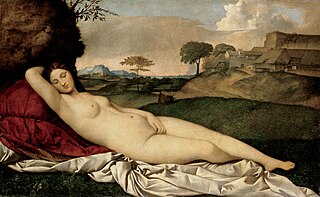
The Sleeping Venus, also known as the Dresden Venus, is a painting traditionally attributed to the Italian Renaissance painter Giorgione, although it has long been widely thought that Titian completed it after Giorgione's death in 1510. The landscape and sky are generally accepted to be mainly by Titian. In the 21st century, much scholarly opinion has shifted further, to see the nude figure of Venus as also painted by Titian, leaving Giorgione's contribution uncertain. It is in the Gemäldegalerie, Dresden. After World War II, the painting was briefly in possession of the Soviet Union.
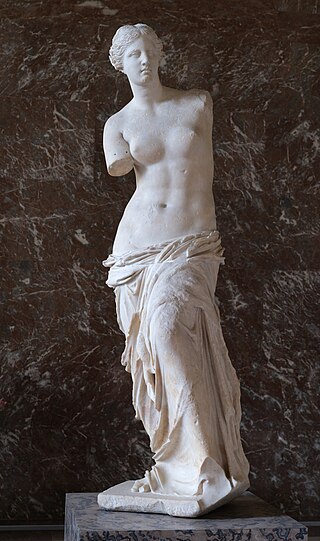
Depictions of nudity include all of the representations or portrayals of the unclothed human body in visual media. In a picture-making civilization, pictorial conventions continually reaffirm what is natural in human appearance, which is part of socialization. In Western societies, the contexts for depictions of nudity include information, art and pornography. Information includes both science and education. Any ambiguous image not easily fitting into one of these categories may be misinterpreted, leading to disputes. The most contentious disputes are between fine art and erotic images, which define the legal distinction of which images are permitted or prohibited.
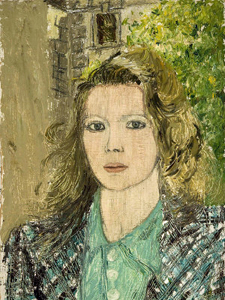
Sylvia Sleigh was a Welsh-born naturalised American realist painter who lived and worked in New York City. She is known for her role in the feminist art movement and especially for reversing traditional gender roles in her paintings of nude men, often using conventional female poses from historical paintings by male artists like Diego Vélazquez, Titian, and Jean-Auguste-Dominique Ingres. Her most well-known subjects were art critics, feminist artists, and her husband, Lawrence Alloway.

Nude photography is the creation of any photograph which contains an image of a nude or semi-nude person, or an image suggestive of nudity. Nude photography is undertaken for a variety of purposes, including educational uses, commercial applications and artistic creations.
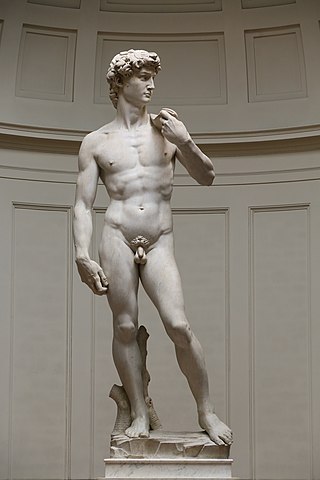
The nude, as a form of visual art that focuses on the unclothed human figure, is an enduring tradition in Western art. It was a preoccupation of Ancient Greek art, and after a semi-dormant period in the Middle Ages returned to a central position with the Renaissance. Unclothed figures often also play a part in other types of art, such as history painting, including allegorical and religious art, portraiture, or the decorative arts. From prehistory to the earliest civilizations, nude female figures were generally understood to be symbols of fertility or well-being.

Horace Day, also Horace Talmage Day, was an American painter of the American scene who came to maturity during the Thirties and was active as a painter over the next 50 years. He traveled widely in the United States and continued to explore throughout his life subjects that first captured his attention as an artist in the Thirties. He gained early recognition for his portraits and landscapes, particularly his paintings in the Carolina Lowcountry.

James West Fraser is an American artist. One of the leading artists in the representational/En Plein Air tradition, Fraser has built his career on richly painted, atmospheric vistas of cities, coasts, and landscapes.

Fine art nude photography is a genre of fine-art photography which depicts the nude human body with an emphasis on form, composition, emotional content, and other aesthetic qualities. The nude has been a prominent subject of photography since its invention, and played an important role in establishing photography as a fine art medium. The distinction between fine art photography and other subgenres is not absolute, but there are certain defining characteristics.

Joan Semmel is an American feminist painter and professor emeritus in painting. She is best known for her large-scale naturalistic nude self portraits as seen from her perspective looking down.

After the Bath, Woman Drying Herself is a pastel drawing by Edgar Degas, made between 1890 and 1895. Since 1959, it has been in the collection of the National Gallery, London. This work is one in a series of pastels and oils that Degas created depicting female nudes. Originally, Degas exhibited his works at Impressionist exhibitions in Paris, where he gained a loyal following.

William M. Halsey (1915–1999) was an influential abstract artist in the American Southeast, particularly in his home state of South Carolina. He was represented by the Bertha Schaefer Gallery in New York City (1948–53). His mural studies for the Baltimore Hebrew Congregational Temple were included in Synagogue Art Today at the Jewish Museum, New York City (1952). His work was included in the annual International Exhibition of Watercolors, the Art Institute of Chicago. He had work in the Whitney Museum's Annual Exhibition of Contemporary American Sculpture, Watercolors and Drawings (1953). A mid-career retrospective was held at the Greenville County Museum of Art in 1972 and then traveled to the Gibbes Museum of Art, Charleston, South Carolina, and the Florence Museum, Florence, South Carolina.

Candaules, King of Lydia, Shews his Wife by Stealth to Gyges, One of his Ministers, as She Goes to Bed, rarely known as The Imprudence of Candaules, is a 45.1 by 55.9 cm oil painting on canvas by English artist William Etty, first exhibited at the Royal Academy in 1830. It shows a scene from the Histories by Herodotus, in which Candaules, king of Lydia, invites his bodyguard Gyges to hide in the couple's bedroom and watch his wife Nyssia undress, to prove to him her beauty. Nyssia notices Gyges spying and challenges him to either accept his own execution or to kill Candaules as a punishment. Gyges chooses to kill Candaules and take his place as king. The painting shows the moment at which Nyssia, still unaware that she is being watched by anyone other than her husband, removes the last of her clothes.
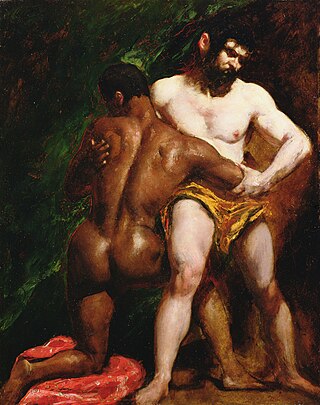
The Wrestlers is an oil painting on millboard by English artist William Etty, painted around 1840 and currently in the York Art Gallery, in York, England. It depicts a wrestling match between a black man and a white man, both glistening with sweat and under an intense light emphasising their curves and musculature. While little documentation of the painting exists prior to 1947, it is likely that it was painted over a period of three evenings at the life class of the Royal Academy.

Musidora: The Bather 'At the Doubtful Breeze Alarmed', also known as The Bather, is a name given to four nearly identical oil paintings on canvas by English artist William Etty. The paintings illustrate a scene from James Thomson's 1727 poem Summer in which a young man accidentally sees a young woman bathing naked and is torn between his desire to look and his knowledge that he ought to look away. The scene was popular with English artists as it was one of the few legitimate pretexts to paint nudes at a time when the display and distribution of nude imagery was suppressed.

Female Nude is an 1876 painting by Pierre-Auguste Renoir, also known as Nude Woman Sitting on a Couch, Anna, After Bathing and Pearl. It is housed in the Pushkin Museum, in Moscow, and is an example of Renoir's many nude paintings, a recurring subject that preoccupied him throughout his life. The painting was created in the characteristic soft brush strokes of the Impressionist movement to emphasise feminine beauty.
Bruno Civitico was an Italian-born American painter, draughtsman and teacher. He is widely considered to be "a major player in the development of Classicism," and "one of the most important artists of the Neoclassical Figurative revival movement."
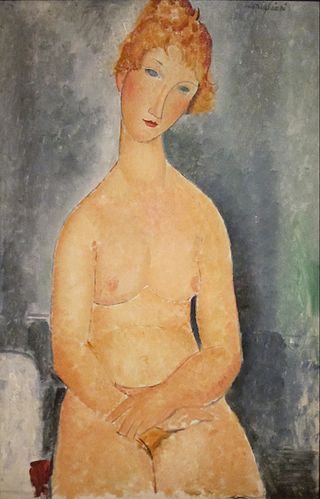
Seated Nude is an oil on canvas painting by Italian artist Amedeo Modigliani created in 1918. The painting is one of the dozens of nudes created by Modigliani between 1916 and 1919.

















